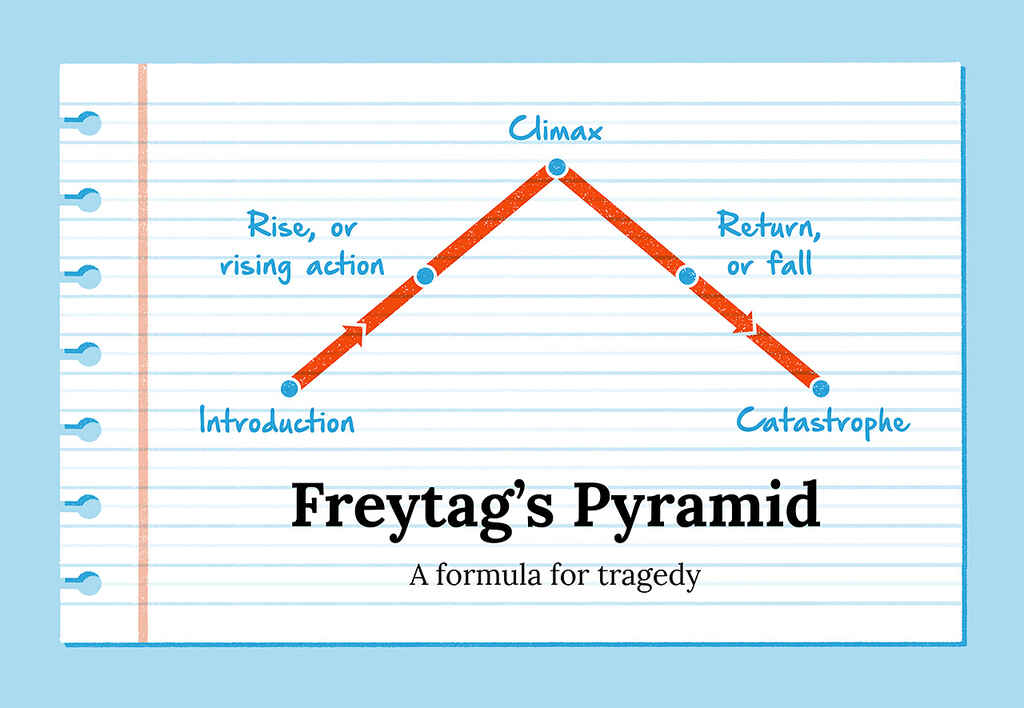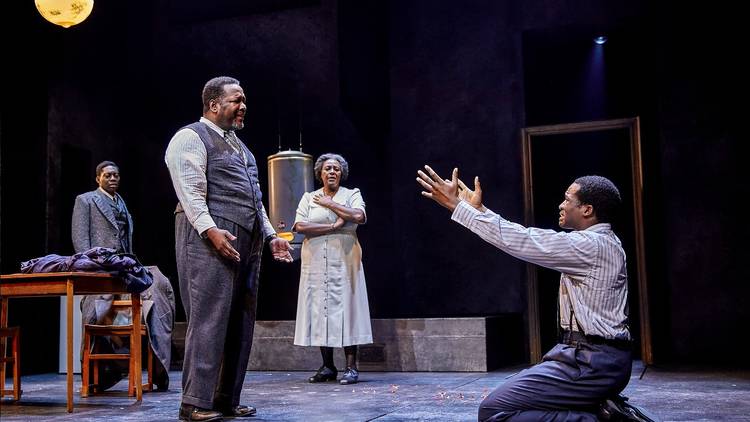Guides • Perfecting your Craft
Last updated on Jul 25, 2022
Freytag’s Pyramid: Understand the Shape of Tragic Drama
About the author
Reedsy's editorial team is a diverse group of industry experts devoted to helping authors write and publish beautiful books.
More about the Reedsy Editorial Team →Savannah Cordova
Savannah is a senior editor with Reedsy and a published writer whose work has appeared on Slate, Kirkus, and BookTrib. Her short fiction has appeared in the Owl Canyon Press anthology, "No Bars and a Dead Battery".
View profile →Freytag’s pyramid is a dramatic structure introduced by German 19th-century writer Gustav Freytag. The pyramid, also known as "Freytag’s triangle", is a straightforward way of organizing a tragic narrative into a beginning, middle, and ending, and is comprised of five distinct parts; introduction, rise, climax, return, and catastrophe.
Read on to discover the acts that make up Freytag’s pyramid, and pay close attention as we apply each to Arthur Miller’s play Death of a Salesman. You’ll be a Freytag expert in no time.
What is Freytag’s Pyramid?

Freytag was interested in classical Greek tragedy and Shakespearean drama, and devised his pyramid by observing their structural patterns.
Make no mistake: Freytag’s pyramid is not a one-size-fits-all structure. It identifies story elements that are common to classical and Shakespearean tragedies, including a revelation or plot twist that changes everything — resulting in catastrophe for the hero.
As a result, the pyramid is less applicable to non-tragic narratives in which the protagonist usually wins out in some way, or when writing more upbeat genres like comedy. Freytag’s five-act framework is notably one of many approaches that writers can use to create a complete and satisfying story for readers.
A note before we dive in: despite the fact that the pyramid was originally based on drama, Freytag’s ideas are ultimately about storytelling, so they can also apply to both fiction and non-fiction writing — books, plays, TV, film, novels, memoirs, and short stories alike.
Want to know what kind of characters populate Freytag's Pyramid? Check out this post on tragic heroes to find out.
The 5 stages of Freytag’s pyramid
Though you may encounter explanations of the pyramid that identify 7 elements, Freytag’s original narrative arc only refers to 5 key acts:
- Introduction: Establish the characters and stakes.
- Rise, or rising action: Things seem to be on the up.
- Climax: The world is turned upside-down.
- Return, or fall: We’re heading for tragedy.
- Catastrophe: The inevitable becomes true.
Let’s break down what each of Freytag’s acts entails, from hopeful beginnings, to fraught middle, to a tragic ending. To demonstrate how every act applies to an actual story, we’ve followed them with a Death of a Salesman example. If you aren’t familiar with this classic play, consider this your spoiler warning (and your trigger warning for mention of suicide)!

FREE COURSE
How to Plot a Novel in Three Acts
In 10 days, learn how to plot a novel that keeps readers hooked
1: Introduction
This beginning act is designed to orient the reader and set the story in motion. It asks and answers the question “where am I?” followed by “what is happening?”. As the reader (or audience), you are brought into a new environment — so the first act needs to establish the circumstances in which the characters find themselves, and introduce readers to the world and the way htings are normally.
Some writers subdivide the first act into the ‘exposition’ and the ‘inciting incident’; these correspond to the first and second questions above.
The exposition provides information about the characters and the relationships between them, as well as any backstory required to understand the stakes of the plot. Think the introductory scenes of Macbeth, where we are introduced to the key players in the aftermath of a great military victory, and learn about their relationships to one another.
The inciting incident is the first point of deviation from the norm — an event, discovery, or new idea that triggers change. Returning to Macbeth, this would be when the witches share their prophecy with Macbeth, setting him off on a new course of action.
Example: Meet Willy Loman

The play begins on an evening in 1949 when aged salesman Willy Loman returns to his Brooklyn home. In a conversation with Linda, his wife, it emerges that his once-promising career is failing. Their adult sons, Happy and Biff, are asleep, and the audience witnesses their parents’ anxieties about Biff’s unstable lifestyle.
The inciting incident arrives when Linda suggests that Willy speaks to his boss about his difficulties, to secure a local job that won’t require him to drive far anymore.
Learn to establish your characters with our free 10-day course:

FREE COURSE
How to Develop Characters
In 10 days, learn to develop complex characters readers will love.
2. Rise, or rising action
The second act of Freytag’s pyramid is an in-between period of rising tension and escalating plot complexity. The events kickstarted by the inciting incident now pick up momentum as Act 2 reveals what’s at stake for the characters while offering a false promise of hope: a light at the end of the tunnel. The stakes, tension, and hope manifest as suspense, anxiety, or new insights into your character.
In Antigone, the rising action is the period where tragic heroine Antigone struggles to secure an honorable burial for her brother, against her uncle’s wishes. Despite hope her sister may help, she is ultimately unwilling, and Antigone’s desperation grows.
If we visualize the introduction as the moment the snowball takes form, the rise is the real snowball effect: the growing, spiraling acceleration towards a climax.
Example: Biff and Happy’s growing concerns
Several minor scenes make up the rising action part of the play, but briefly:
- Biff and Happy discuss their restless disillusionment with their present lives and their father’s increasingly irresponsible night driving.
- Biff and Happy decry their father’s helplessness to their mother, but she defends him, explaining their financial hardships and confessing that Willy has attempted suicide.
3. Climax
In the tragedy model, the climax isn’t the big confrontation at the end — Frodo at Mt Doom, Superman facing off against Lex Luther — but a point of no return. It’s like reaching the top of a rollercoaster — the illusion of control is lost as gravity takes over. It’s a turning point, and it changes everything.
Sometimes, the climax is a highly dramatic event, like Medea killing her children. Other times, it takes the form of an inner realization, like a new awareness of one’s cowardice and a resulting determination to face one’s fears. Afterward, the plot continues to progress, but it does so in light of the climax and its revelations.
In tragedy, the climax is the point where the plot begins to unravel, with everything now taking a turn for the worse.
Example: Willy reaches breaking point

With the knowledge that Willy has suicidal thoughts, the audience understands that, should the family’s bad luck continue, Willy will be tempted by the idea of a life insurance payout rescuing his family.
Tension reaches a new peak when Willy asks his young boss for a job in New York. The boss refuses and fires him, leaving Willy betrayed and angry. From this point onward, the plot spirals out of the characters’ control, leading them downward on their way to catastrophe.
4. Return, or fall
Once the protagonist crosses the point of no return, the plot speeds forward with a growing sense of inevitability. This is tragedy, so the audience always feels a sense of imminent disaster. In the return phase, also known as the reversal, we are presented with moments of tension as in Act 2, but this time tension hits harder, because of everything that has preceded it.
Theatrical director Ivo van Hove, discussing his production of Miller’s A View From the Bridge, used a description that perfectly captured the audience’s transfixed and helpless state in Act 4: “It's as if you see two cars, and they are driving towards each other, and you know what will happen.” In other words, Act 4 is when the inevitability of tragedy becomes all too clear, and the tension becomes unbearable.
Example: The truth revealed
Like Act 2, the return or fall phase of Freytag’s pyramid consists of several scenes of tension. One takes place when the Lomans go out for dinner: Willy confesses that he’s lost his job, and Biff — who has failed to secure a deal his father was optimistic about — tries to relate this news in a painless way. A flashback reveals young Biff discovering his father’s affair, casting their difficult relationship in a new, tragic light. Finally, Biff and Willy clash in a furious argument over Biff’s professional failure.
5: Catastrophe
Catastrophe takes place when the character is finally brought to their lowest point. Like the climax, catastrophe may take many forms: a character could die, be financially ruined, or lose everyone’s respect. Everything the character has feared from Act 1 comes true. Think Oedipus’ blinding, or Lennie’s death in Of Mice and Men. Whatever the catastrophe is, it’s a forceful conclusion to the build-up of tension, the moment everything comes crashing down.
Though Freytag’s original analysis didn’t discuss denouements, people sometimes treat these as the seventh element of his pyramid. A denouement brings resolution, settling all remaining questions and tidying up loose elements of the narrative. It can also suggest how the story moves onward after tragedy.
Example: The Lomans get the money, but at what cost?

Catastrophe hits Death of a Salesman when Willy intentionally kills himself in a car wreck, allowing his family to claim a $20,000 insurance payout. His death does not come as a surprise, but it still hits hard, forcefully shattering his family’s chances of happiness. In a pattern that recurs in tragedies, the Lomans get what they want, but at a great and irreversible cost.
A denouement takes place at the very end of the play, after Willy’s funeral. The audience finds out what his sons plan to do now, and, amidst her grief, Linda provides an unlikely sense of resolution as she utters, “We’re free…” The denouement makes explicit something we may have realized at the moment of catastrophe: that her husband’s tragic arc is also her own; that she will have to live with the consequences of her actions.
When should writers use Freytag’s pyramid?
If you’re wondering why an author would choose to use Freytag as a model, or are an author yourself considering it, here are three instances when you might wish to choose Freytag’s pyramid as a story structure.
To create empathy in the reader
As a linear dramatic structure, Freytag’s pyramid operates subliminally. You aren’t thinking about act breaks and story beats when you read a novel, but you’re under its structure's spell anyway. A narrative that follows this pyramid’s flow guides the reader towards understanding what’s at stake for the characters.
You wouldn’t appreciate a climax if you didn't understand its impact on the status quo, just as you wouldn’t even recognize rising action if you didn’t know what was new. You need to understand a character's experiences to empathize with them. This pyramid structure maps the story into a pattern all humans are familiar with: desperately wanting something, only to be denied it.
When telling stories that center around human flaws
If the beating heart of your story is the strengths, weaknesses, and internal conflict of your characters, Freytag’s pyramid is a great framework within which to draw out and examine these elements. The pyramid shows every step of our fatally flawed tragic hero’s journey, from the status quo when their flaws are still (just about) under control, to the point of no return when they finally get the better of them, to their ultimate demise. If you’re writing an intense character study, Freytag is a good roadmap.

For downbeat endings that pack a punch
The beauty of a distinct dramatic structure like Freytag’s pyramid is that the framework is designed to make stories satisfying. When done right, following Freytag’s pyramid when writing means readers will understand the purpose of each scene in relation to where it is in the story (e.g. to escalate the stakes, or push the character towards catastrophe). The tragic endings of stories written with Freytag in mind are substantive and impactful — not just sadness for sadness’ sake.
Now that you're a bona fide Freytag expert, check out the rest of the posts in our guide for more insight into the wonderful world of story structure.



